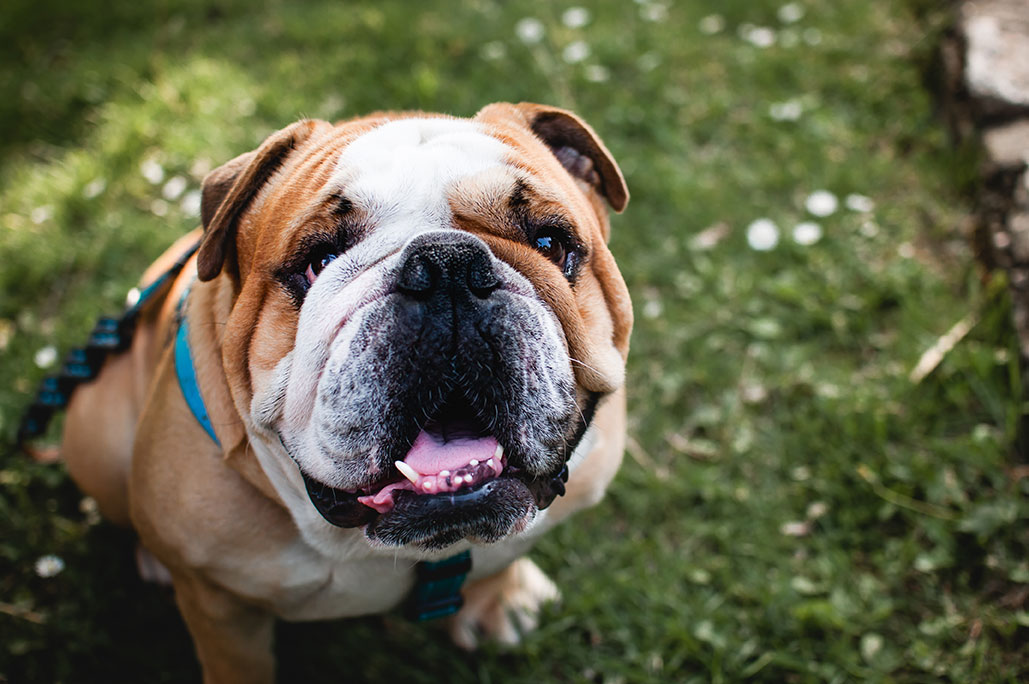![]()
Bulldogs are cute, adorable dogs with great personalities and features distinct from most other dog breeds. The breed can exhibit especially distinct facial skin folds, tail folds and thick stubby legs and feet apart from many other features related to these dogs. Possessing these facial folds and other skin folds means they are more prone to skin problems from a combination of chafing, heat, and moisture. Two major problems to be aware of are skin fold dermatitis (also called intertrigo) and pyoderma (bacterial skin infection). When detected and then properly treated, your bulldog can have a happy, healthy life. Often, skin fold concerns may need to be managed over time to prevent recurrent problems and need for therapy.
What Causes Facial Folds in Bulldogs?
Deep folds in bulldogs can be the result of breeding as well as individual variation. In-breeding for selection of flat faces can play a role as flat, pushed-in faces and prominent face folds can make bulldogs look adorable, but most breeders are aware that these features also make dogs more prone to having an increased risk of multiple health problems. Thus, responsible breeders are helping limit breed-related problems. Of these problems, facial fold dermatitis (intertrigo) may not be the most severe, but it can definitely affect a pet’s quality of life. If the dog happens to be affected by other skin problems such as environmental or food allergies, these may lead to inflamed skin which would accentuate the skin folds and chances of them getting infected. Other areas with prominent skin folds in dogs include:
- Tail fold at base of tail
- Arm pit area
- Peri-vulvar folds
- Head wrinkles in some dogs
- Paws
Areas with skin folds result in a warm and moist environment within the crease of the skin and may nourish bacteria and yeast growth. These organisms are present on healthy skin (with or without folds) but if provided with the moist, warm location these microbes can flourish and multiply to levels that cause skin infection and discomfort to the pet.
Skin Fold Pyoderma
Pyoderma is a bacterial infection of the skin, which causes lesions such as erythema (skin redness), alopecia (hair loss), crusting and pustules (inflamed pus-filled pimples). Other symptoms of localized skin fold pyoderma may include:
- Moist skin fold
- A dried discharge within the fold
- Itchiness
- Odour
- Brown staining of hair close to the fold
Prevention
Keeping your dog at a healthy weight can help to reduce the prominence of some body folds. But since folds are part of the bulldogs’ characteristic makeup, talk to your vet about the areas that may be affected. Keep them clean by washing those areas with an antimicrobial product that is gentle on the skin and keeping moisture to a minimum is helpful. Steroidal creams, scrubbing of the affected area, dry paper towels can all temporarily seem to help but are likely to cause worsening of the localized skin fold dermatitis. If an infection has already set in, it may need to be treated by your veterinarian prior to pursuing ongoing management of the affected skin fold.
Skin Fold Yeast Dermatitis
Similar to bacterial skin infection of the skin folds, yeast infections (often the Malassezia yeast) can lead to itchiness, discomfort, inflammation and redness within and around the skin folds. If a yeast infection were present within the fold, it would have to be treated before ongoing management can be pursued to prevent future infections. A mixed infection of bacteria and yeast may also be present within the folds. Your veterinarian should be able to differentiate between yeast and bacteria quite easily by pursuing a quick test called skin cytology.
To ensure appropriate therapy, it is best to diagnose the type of infection based on skin cytology testing, rather than guessing if the inflamed skin fold contains bacteria or yeast in it.
Tail Fold Dermatitis and Some Other Similar Forms
English and French bulldog pups can suffer from abnormal tail bone growth that will twist the skin around and under the sacral vertebrae creating a deep pocket of skin folds. This condition is sometimes called the corkscrew tail. Management of tail folds can be more hands-on. It’s best to familiarize yourself with the curvatures and depth of the folds with your fingers. Take a medicated wipe and wipe 360 degrees in the tail fold and gently wipe the deep fold. Some pets can be quite sensitive in this area if an infection is present.
Female dogs of many breeds can also develop vaginal skin fold dermatitis.
Bassett hounds may be prone to armpit and groin fold dermatitis.
Dogs possess a small fold on the lower lip on each side, which is more pronounced in some breeds of dogs. Lip fold dermatitis may occur in some of these dogs.
Treatment for Skin Fold Dermatitis
Usually treatment includes frequent antimicrobial products based on the nature of the infection within the skin fold. Topical therapy is usually adequate. Some dogs may be prone to severe infections or recurrence of infection within skin folds. Such dogs may unfortunately require surgical treatment to remove deep facial folds to prevent inflammation and microbial build up. Most pets with skin fold dermatitis can be managed well with ongoing care that is usually not expensive and quite easy to administer. It is vital to remember that a dog affected by recurrent skin fold problems may in fact be demonstrating skin fold problems as a clue to underlying skin disease such as allergies. This is especially true if ears or other parts of skin are also affected.
Bulldog breeds are also predisposed to environmental allergies along with having prominent skin folds. Such patients would greatly benefit from diagnosis and control of the underlying disease in addition to on-going skin fold management.
Creative Commons Attribution: Permission is granted to repost this article in its entirety with credit to VetDERM Clinic and a clickable link back to this page.

Dr. Jangi Bajwa is a Board certified veterinary dermatologist at VetDERM Clinic in Surrey BC. He is also the dermatology feature editor for Canadian Veterinary Journal. Dr. Bajwa’s special interests include otitis and allergic disease in pets; as well as helping improve quality of life of pets and their families.



 by
by